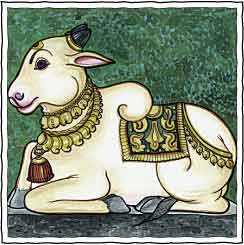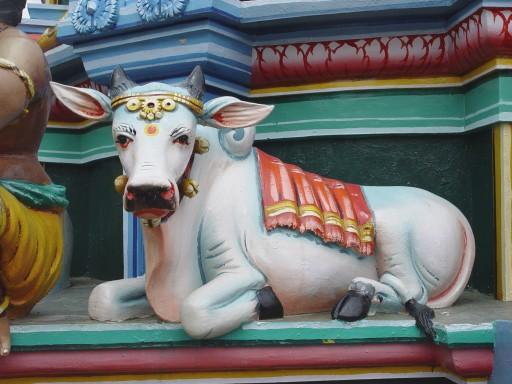|
|
|||
 |
|||
|
TATTOO DESIGNS & SYMBOLS - NANDI TATTOOS
Tattoo Symbol Index - A B C D E F G H I J K L M N O P Q R S T U V W X Y Z Tattoo designs - N >> Nandi
A humble and respectful powerhouse - such a tattoo motif may be deeply in tune with the changing times we live in.
In the Hindu religion, Nandi became revered as the symbol of the renewal of fertility, correct motivation, and religious aspiration. Only by perpetuating these personal attributes can every aspect of divine law flourish. Nandi's devotion to his master went all the way - to the point of sacrificing his own life. The myth tells of Shiva ingesting the 'poison of human Karma' as a display of self-sacrifice. Seeing his master prepared to lay down his life, Nandi was willing to do the same. Shiva, realizing that his beloved vahara could not withstand the effects of the poison as he could, Shiva protected Nandi from his fate. After that, Nandi never left Shiva's side, becoming his ever-present guardian and the source of devotion for followers of Shiva. Lord Shiva, by riding such a powerful symbol of sexual energy and fertility, demonstrates his control over those very forces. Nandi, the constant companion of Lord Shiva, symbolizes the metaphysical ideal in the natural, physical form. The image of Nandi can be seen in Hindu homes throughout India. Statues of the sacred bull - usually with legs bent beneath him in passive mode, ready to heed the call of Lord Shiva - appears outside temples and shrines where Shiva is revered. The believer asks for Nandi's blessing before passing the threshold to the place of worship. Sometimes Nandi is portrayed as pure white, the colour worn by initiates, although he is often depicted as black, symbolizing the earth. Popular paintings and carvings show him carrying Shiva and his consort, Parvati, on his back.
In long-ago India and Sri Lanka, the bull was a primary god in his own right among farmers and herdsmen. Coins inscribed with the image of Nandi date back more than a thousand years, indicating that the bull was both a sacrificial and sacred animal. Nandi was depicted by those ancients as being bull-faced with a human body. Bull worship was prominent in cultures that made an early transition from hunter-gatherer economies to agriculture. It follows that cattle would be among the very first animals to be domesticated. As such, the bull was no longer used in ritual sacrifice, nor was it eaten by devout Hindus.
In the Tamil language, Nandi means 'one who blocks the way', making him an appropriate guardian of Shiva's shrine. Get inspired by some really great images and photos in our Nandi Inspiration Gallery See also: Bull Tattoo Designs, Taurus Tattoo Designs, Shiva Tattoo designs - N >> Nandi Tattoo Symbol Index - A B C D E F G H I J K L M N O P Q R S T U V W X Y Z |
||
| Celeb Tattoos | Facts & Stats | Designs & Symbols | History | Culture | Links | Tattoo Galleries | Contact | |||
|
|
|||


 Nandi Tattoos - In most
mythologies, the bull is an embodiment of male potency, strength,
virility and power. This does not apply to Nandi, however, the bull
of the Hindu god,
Nandi Tattoos - In most
mythologies, the bull is an embodiment of male potency, strength,
virility and power. This does not apply to Nandi, however, the bull
of the Hindu god, 